Introduction
The modern business environment is built on software applications. To get work done faster and more efficiently, IT teams used to have to create lines of code to turn business logic into intuitive software solutions.
While traditional coding will continue to be significant in the future (and in many circumstances, it’s the more realistic solution), decision-makers must now seriously consider their options and decide which method of software development will be most useful to them. We will compare low-code to traditional software development to assist you in choosing the most appropriate option.
Traditional Development: The Established Approach
Traditional Development Essence: Manual Coding First
The traditional programming approach (also known as custom software development) involves manual coding. To develop a custom application using the traditional development approach, you or your developers must write lines of code.
Imagine making a treehouse. You’d need materials, tools, a house plan, and an experienced carpenter. It’s not much different when it comes to developing a custom app. You would require:
- software requirements specifications;
- competent app developers;
- suitable tech stack;
- code writing and management software.
Of course, you can now buy off-the-shelf code or use open-source libraries and other code parts to speed up the development of your software. Still, the basics with traditional app development is that experienced developers are required to write code and shape it into a working program.
However, in the ever-changing technological landscape, the argument of high-code vs. low-code has become more common, emphasising the need to determine which strategy best corresponds with your individual business needs and objectives in dynamic areas like Healthcare and Fintech.
Traditional Development Advantages
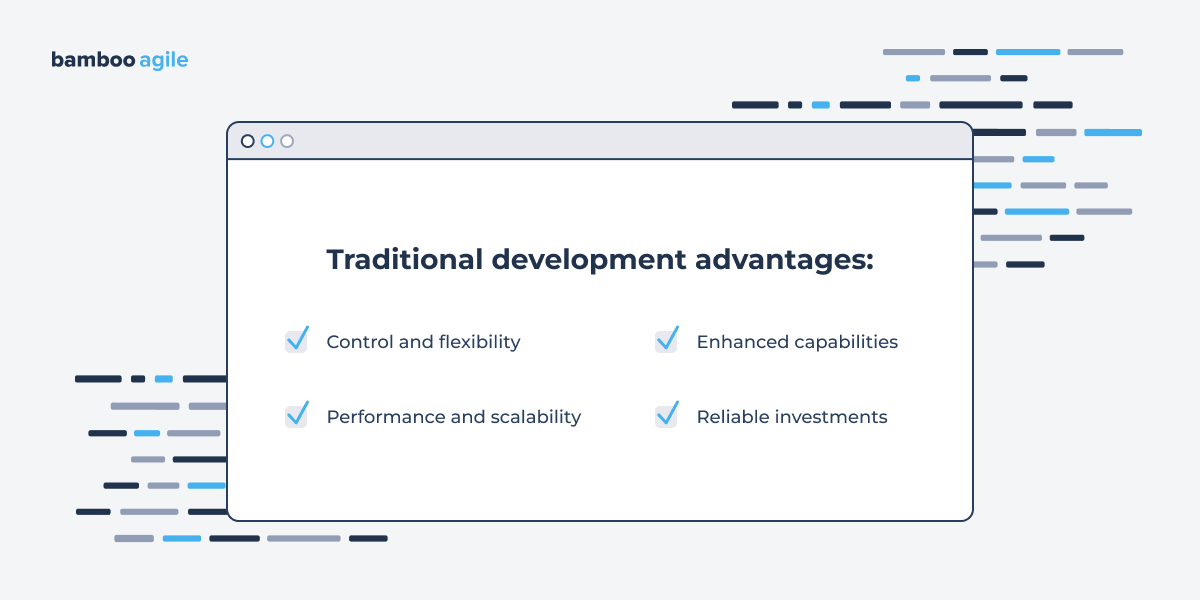
There must be a reason why businesses prefer traditional development over low-code development. Let’s look at the advantages of custom software development.
Control and Flexibility
Traditional programming provides developers with complete flexibility and control over the creation of highly sophisticated, customised solutions that answer specific business requirements. They have complete control over the code, architecture, data models, workflows, and other factors.
This level of control enables handling of highly dynamic, complex logic and edge cases that would be impossible to handle on pre-built systems. Custom code allows the development of truly unique offerings with innovative features and capabilities that are not achievable with low-code technologies.
Performance and Scalability
Engineers may optimise performance at scale by writing efficient algorithms and infrastructure using top technology stacks. By utilising advanced techniques such as caching, multithreading, clustering, and other optimisations, they can ensure strong scalability in the face of rapid workload spikes and growth. Low-code systems may have difficulty providing the same level of control and approaches when great performance at scale is required.
Enhanced Capabilities
Traditional app development gives you more direct access to cutting-edge and upcoming technologies that are not yet available in low-code platforms. Engineers can incorporate language, framework, protocol, and other advancements faster than platform vendors can. This allows for the development of advanced interfaces and experiences such as VR, AR, and AI-based apps that would not be possible with configuration-based tools.
Reliable Investments
While low-code risks lock in, custom code is platform-agnostic and flexibly connected to avoid chokepoints. Additionally, because the client corporation owns the bespoke code, it is less vulnerable to vendor changes. This makes custom applications more secure and avoids over-reliance on the roadmap and continuous presence of a single low-code provider.
Traditional Development Limitations
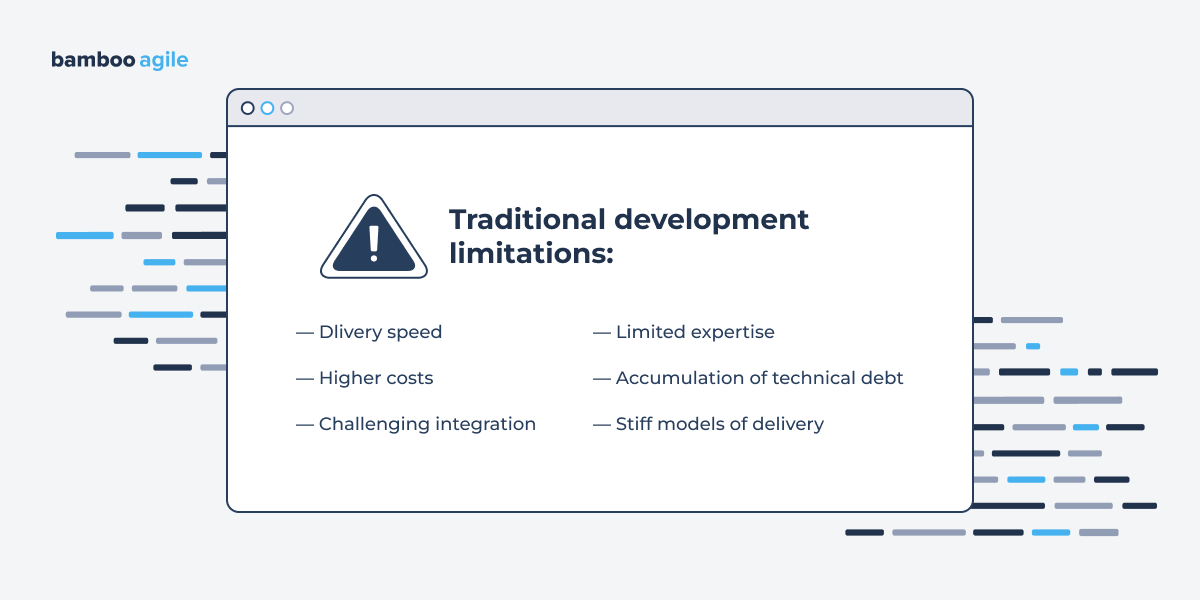
Delivery Speed
Traditional bespoke code development has longer delivery time frames than low-code methods. With big teams, the large amount of hand-coding required leads software solutions to take several months or even years to build, test, and launch. The time-consuming custom development process reduces efficiency and time-to-market.
Higher Costs
Custom app development’s large amount of necessary developer resources and lengthy deadlines result in greater prices than low-code costs. Custom applications frequently necessitate huge, highly trained teams working for months on design, coding, testing, integration, and release.
Challenging Integration
It can be difficult to integrate custom applications with the existing infrastructure. The so-called integration friction may occur, which is caused by tight connectivity between custom components. Low-code systems enable easier connection.
Limited Expertise
Finding developers who are proficient in specific languages and frameworks for custom development might be difficult. Low-code allows even non-programmers to build apps. Custom code relies on limited expertise, which may reduce the available talent pool.
Accumulation of Technical Debt
Over time, monolithic bespoke code accumulates enormous technical debt, making maintenance, upgrades, and revision difficult. Tight coupling and a lack of reusability in custom programs limit long-term developer productivity.
Stiff Models of Delivery
Traditional waterfall or hybrid methods are usually used for custom code. These long bespoke development deadlines limit the ability to change features in the middle of the process. Low-code allows increased adaptability with iterative delivery methods like Agile.
Low-Code Development: a Disruptive Technology
Low-Code Development: a Disruptive Innovation
Low-code development is a software development strategy that involves the use of a graphical user interface with drag-and-drop capabilities, as well as the ability to directly modify an app’s code by rewriting or modifying portions of the baseline code.
As was said, the term “low-code” refers to the very limited use of code for building an application. But while this approach can be utilised by people with limited coding skills, it’s mostly intended for developers who already know how to code and can thus use low-code instruments more efficiently.
A non-coder can also use low-code platforms to create simple programs. The sole restriction is that they will only be able to build and rearrange ready-made blocks. As a result, the primary benefit of a low-code platform (easy template-based modification) is lost in this case.
Consider workers fitting together ready-made blocks to build a house as an example of low-code development. They take ready-made wall fragments, pipes, and roof components and assemble them.
Working in a low-code environment, however, allows workers to fine-tune and even significantly modify each and every block. In other words, with low-code, they can dive into each preset and perform “behind-the-scenes” modifications that typical users dealing with code through a graphical interface do not have access to.
Key Features of Low-Code Development
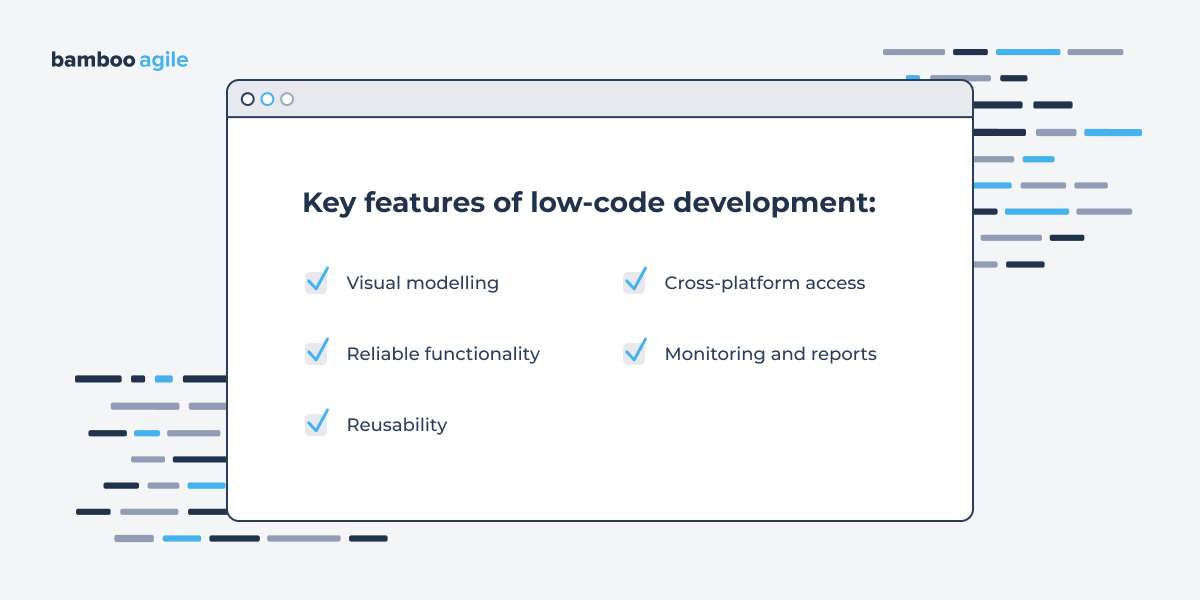
Visual Modelling
In low-code platforms, complex code can be replaced by a drag-and-drop interface. They enable developers to easily analyse and manage data through visual modelling.
Reliable Functionality
Notable low-code systems include out-of-the-box functionality, which eliminates the need to create key program modules from scratch. Some code platforms provide pre-built core modules such as customer service management, data management, and so on.
Reusability
The use of pre-configured modules and functionality for apps is another important part of low-code development. These modules typically contain all of the same core functionalities required for various apps, and they can be rapidly reused for multiple alternative solutions.
Cross-Platform Access
One of the most desired features of low-code platforms is multi-device connectivity. Aside from allowing customers to use the low-code platform on all gadgets running key operational systems, cross-platform compatibility allows users to create programs that can run on all core platforms and devices.
Monitoring and Reports
Apps created with the low-code technique can monitor workflows and processes to determine their effectiveness. Furthermore, they can follow the performance of other apps and are particularly valuable for analytical purposes.
Existing Low-Code Platforms and Their Features
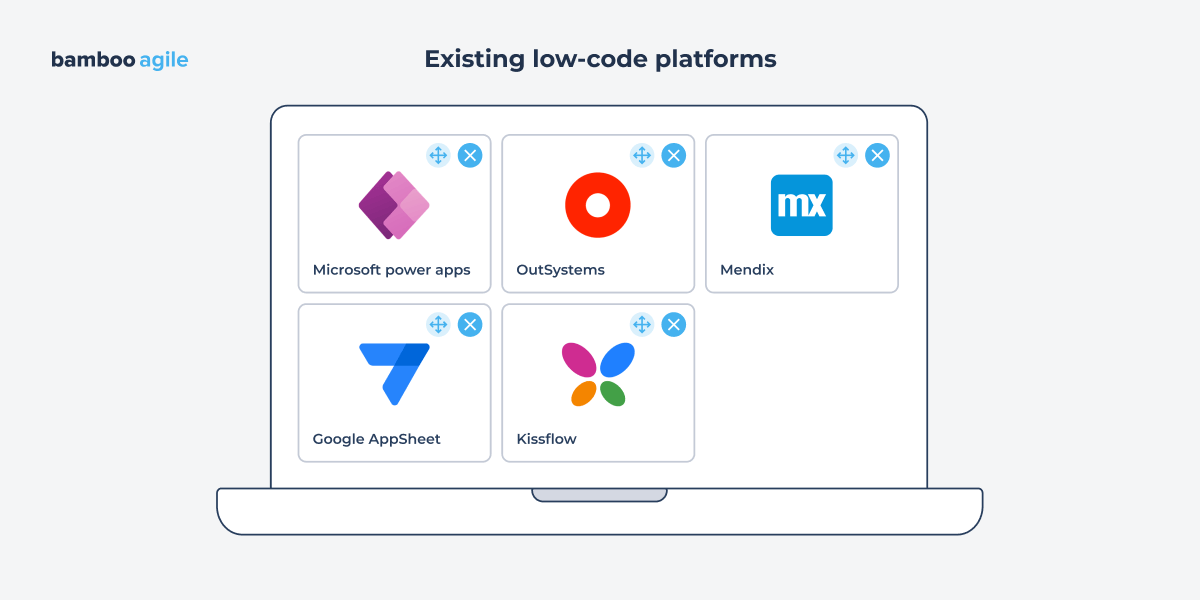
Microsoft Power Apps
Microsoft Power Apps is a low-code platform that allows you to quickly and easily create unique business apps. The service’s functionality is amazing, particularly because it includes pre-built AI components.
Extensibility is also intriguing, with over 200 connectors to interlink diverse data types and systems.
Features:
- Easy to use drag-and-drop interface;
- Pre-built templates for common app scenarios;
- Connectors to various data sources, such as SharePoint, Excel, and an SQL Server;
- Cloud-based platform with access from any device;
- Integration with Microsoft 365 products.
OutSystems
OutSystems is a low-code platform that enables developers to build enterprise-grade web and mobile applications. It offers a visual development environment, a rich set of pre-built components, and support for cloud-based or on-premises deployment.
Features:
- Model-driven development approach for building apps with less code;
- Visual development environment with drag-and-drop functionality;
- Rich set of pre-built components and connectors;
- Cloud-based or on-premises deployment options;
- Support for enterprise-level scalability and security.
Mendix
Mendix offers low-code software platform tooling for testing, creating, and deploying apps. Mendix, which was founded in 2005, is used by numerous businesses. The platform is built using model-driven engineering (MDE), a development method that emphasises abstract modelling.
Features:
- A model-driven approach for building apps with less code;
- Agile development methodology for faster time to market;
- Cloud-based or on-premises deployment options;
- Strong support for DevOps and continuous integration;
- A rich ecosystem of partners and extensions.
Google AppSheet
Google AppSheet is a platform that offers numerous options for developing mobile applications. You can choose from a huge library of ready-made examples to construct your own software.
Features:
- Easy-to-use interface for building apps from spreadsheets;
- No coding required;
- Cloud-based platform with access from any device;
- Integration with Google Workspace products, such as Google Sheets and Google Drive.
Kissflow
Kissflow describes itself as a “unified digital workplace”. Its primary function is to manage workflow and processes.
Its rule-based paradigm eliminates the need for bespoke coding by allowing you to set conditions for a tailored workflow. This is the cornerstone of low-code development in Kissflow.
Features:
- Business process automation platform with low-code capabilities;
- Visual workflow designer for automating business processes;
- Pre-built templates for common business processes;
- Cloud-based platform with access from any device;
- Mobile app for on-the-go access and task management.
Low-Code Development Benefits

Many firms are now actively implementing low-code solutions after realising the benefits they bring to the development process. According to Gartner, by 2026, developers outside of traditional IT departments would account for at least 80% of low-code development tool users, up from 60% in 2021.
Let’s take a closer look at the low-code advantages that can sway organisations away from traditional development.
Better Agility
Traditional apps take a long time to develop and release in app stores. Because of built-in functionality, reusable templates, and automated testing, low-code development platforms let non-technical individuals and developers alike design and deliver programs faster, enhancing developer agility.
Cost-Efficiency
Low-code development platforms enable organisations to produce apps for immediate use at a lower cost than traditional software development. Traditional development necessitates the formation of an in-house team or the outsourcing of software development. You don’t need all that for low-code development: you can just employ a part-time developer or code alone if you have the right experience.
Fast Adaptability
Because the market and competition are always evolving, you must respond swiftly to dynamically changing business situations. Low-code development platforms enable businesses to update their apps on the fly and stay ahead of the competition.
Stable Features
Low-code platforms provide pre-built features that have been tried and tested. Templates can be effortlessly connected to work efficiently across several devices and platforms, ensuring a great user experience. However, the amount of these templates is restricted, which affects developers’ versatility.
Easy Maintenance and Updates
Updating apps created using traditional development means that IT specialists have to add new functionality and fix bugs. Implementing modifications is easier and more efficient with low-code platforms and their pre-built and pre-tested modules. Furthermore, the chances of incompatibility are negligible.
Low-Code Development Potential Drawbacks
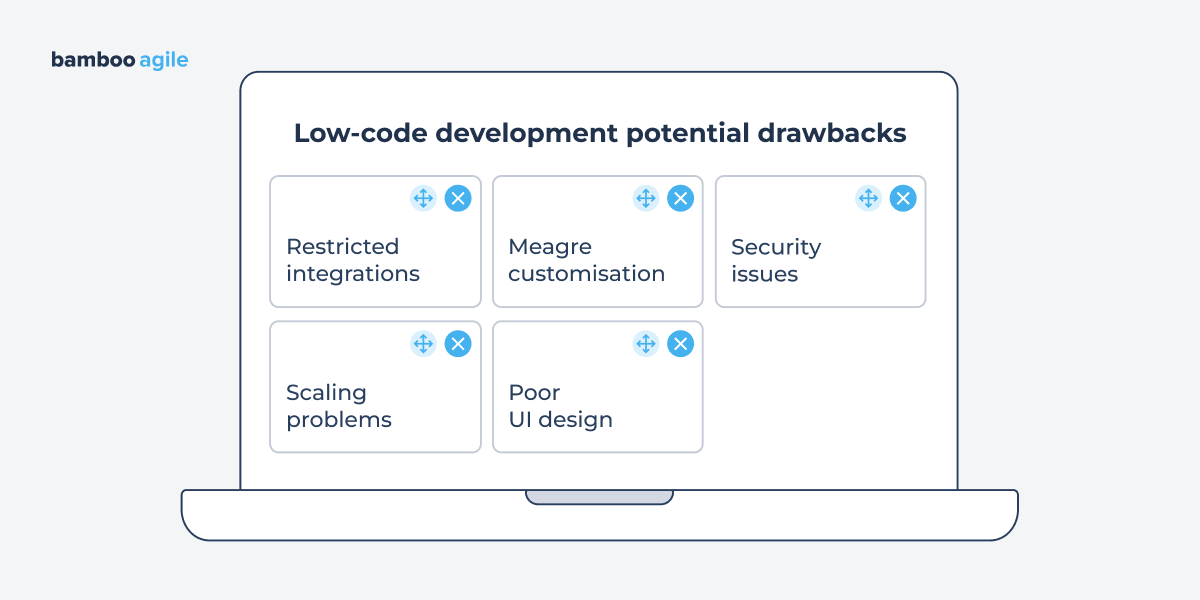
The promise of rapid software development is appealing. But, before you choose low-code development, consider the following drawbacks.
Restricted Integrations
Relying too heavily on low-code platforms for development can lead to integration concerns. Platforms with low code have limited functionality for integrating with most internal systems and third-party services.
Meagre Customisation
Low-code systems’ modular components ensure speedy app development but constrain customisation options. You may need customised elements in your app at some time to fulfil special business objectives. However, if you create an app with a low-code platform, you will most likely need to adapt your business demands to the capabilities of your framework.
Security Issues
Non-tech platform users may cause vulnerabilities that they are unaware of. As a result, hackers can get sensitive user and company data through insecure coding.
However, reliable low-code systems install updates and patches automatically. It is no longer necessary for a developer to implement security fixes, at least on a general level.
Scaling Problems
Low-code development platforms typically perform effectively on smaller projects, but fall short of meeting the needs of huge corporations. Compare low-code platforms to ensure that the platform you select has the scalability your organisation requires.
Poor UI Design
Low-code platforms feature libraries of templates, widgets, and UI components which enable you to develop your programme in hours rather than days. However, while this appears to be a significant gain, it implies that your UI design will not be original or customised.
Low-Code Development Vs Traditional Coding: Comparison
A Comprehensive Comparison Table
| Parameter | Traditional Software Development | Low-Code Software Development |
|---|---|---|
| Approach | Manual coding from scratch with the help of programming languages and frameworks | Visual, drag-and-drop, pre-built components |
| Coding | Manual coding required | Minimal coding required, may use pre-built components |
| Requirements | Upfront definition of requirements | Iterative and evolving requirements |
| Testing | Formal testing plans and procedures | Continuous testing and integration |
| Suitability | Complex, enterprise-level applications. Gives high customisation and control. | Simple to moderately complex applications. May have limitations in customisation and scalability |
| Quality | Depends on the expertise of the development team | Depends on the platform |
| Flexibility | Less flexible, difficult to adapt to changes | More flexible, easier to adapt to changes |
| Time to market | Longer time to market | Shorter time to market |
| Cost | Higher development costs, depends on the developer’s hourly rates | Lower development costs, depend on the subscription plan and the number of users |
| Skillset | Requires experienced software developers | Can be used by non-technical users with minimal training |
| ROI | Longer development and higher costs lead to longer return of investments | Faster development and reduced costs lead to quicker return of investments |
| Integration | Requires manual coding | Rapid integration with APIs and data sources with pre-built connectors |
| Security | Complete control over security measures | Dependent on built-in security measures, risk of misconfigurations |
| Dependence | Portable code for various platforms | High risk of vendor lock-in |
| Ownership | The business owns the developed code | The vendor of the platform owns the tech stack |
Community Opinion on Low-Code Development
We’ve dived into different forums to gather the community’s opinion on low-code development. Opinions were different, however, the general picture is as follows.
“Biggest Con of low-code development is that you’ll outgrow their simplicity, because most low-code platforms are limited in their applications. That said, they still offer a valuable learning experience and can serve as a stepping stone to more advanced programming techniques.”
“They are a great way to get things out in the market quickly without relying on developers, but if you need to scale, they can get unmanageable. Oftentimes you will need to rebuild from scratch in code so there’s an argument that it’s better to start as you mean to go on”
“Low-code basically means someone else has written the code for you, with some level of customisation. They’re very useful until you want to go outside the capabilities of the pre-canned code.”
Bamboo Agile’s Expert Opinion
We asked the CTO of Bamboo Agile Sergey Zubovich about his attitude to low-code development.
“Nowadays, we see a trend where companies within a specific industry, such as Telecom, approach software developers with ideas for applications that share a similar core structure. If a company has experience with such applications, there’s an opportunity to reuse these core structures, adapting them to speed up the process and reduce costs for the client. I firmly believe that this approach is the future of software development.”
Choosing the Proper Approach

Complexity and Scope
The traditional application development strategy often includes a number of tools and functionalities that aid developers in the creation of highly complicated programs. To effectively use these apps, one would need a lot of complex technical expertise in this industry.
Low-code systems, on the other hand, provide a set of tools that can assist you in developing various types of applications with minimal effort. Application development employing the low-code technique becomes significantly easier for non-technical people who lack technical expertise. However, their range of features and capabilities can be very limiting.
Resource and Skill Set Evaluation
In traditional development, you’ll often need to employ a variety of tools and features for designing increasingly complex programs. You’ll require highly competent and sophisticated software professionals to handle those tools well.
Low-code app development lacks a diverse set of tools and functions. Platforms for low-code development allow users with little to no skill in programming develop simple applications without any help, so it’s a good point to start from for beginners.
Development Speed Vs Time Constraints
Take into account the talent and resources available on your development team. Citizen developers and those with no coding experience can participate in the development process thanks to low-code development platforms. Traditional development necessitates greater code knowledge and requires a dedicated team of competent developers.
Future Maintenance
Maintenance is a major pain of traditional coding because updates or revisions require specialised in-house or third-party development specialists to implement changes. Similarly, software modification is a time-consuming process that requires teams to plan, develop, and test new features. Not to mention training users to use the latest modifications.
In contrast, low-code platforms, which are aPaaS (application platform as a service), are often administered and maintained by the platform’s owner. This simplifies the maintenance process because all upgrades and improvements to the software are handled by the hosting firm rather than the business that subscribed to the service.
Scalability
Scalability is a consideration for both low-code and traditional development methodologies.
Scalability in traditional development is frequently achieved through careful design, architecture, and the usage of scalable infrastructure. This level of control enables traditional development to extend horizontally and vertically based on the application’s requirements.
Scalability capabilities like automated scaling and cloud deployment choices are frequently available out of the box in low-code development platforms. These platforms take advantage of the underlying infrastructure to handle greater demand and ensure that the application can support growing user bases. However, control over scalability may be more constrained than in traditional development.
If you have specific performance requirements, complicated algorithms, or real-time processing needs, traditional development may provide the flexibility and control you need to optimise performance. Low-code development, on the other hand, can provide a feasible solution with built-in scalability capabilities.
Will Low-Code Development Outlive Traditional Coding?
The movement to low-code development is far more than just a passing fad; it represents an important change in how software development is handled. The capacity of these platforms to expedite the development process, allowing for faster application delivery with less programming effort, is driving their rapid acceptance.
Low-code technologies provide rapid validation of business ideas, saving both time and money. When project restrictions permit, these platforms are extremely effective at shortening the development cycle.
It is crucial to highlight, however, that the advent of low-code does not mean the end of traditional coding. While these technologies have made software development more accessible, they will not replace developers anytime soon. Instead, they supplement standard development methodologies by providing an alternative way to produce software when the requirements allow.
The future of software development will almost certainly be a hybrid of traditional coding and low-code approaches.
Why Choose Bamboo Agile as Your Development Partner
Bamboo Agile is on the cutting edge of combining traditional and low-code approaches. As was written earlier, the CTO of Bamboo Agile Sergey Zubovich sees great potential in this blend and is ready to offer this approach to clients for custom development solutions.
If you have an ambitious concept but aren’t sure how to put it into action, please fill out this form to contact the Bamboo Agile team. Our industry experts will gladly provide you with a free consultation and assistance in developing your perfect solution.
Conclusion
Through visual configuration-based tools, low-code platforms enable faster and more accessible software development. They empower business users, speed up delivery, and reduce dependency on expert developers. However, these advantages come with restrictions in terms of customisation, control, and performance optimisation.
Custom development in the traditional sense allows for highly personalised, complicated applications with complete control over their code and algorithms. However, it necessitates a great amount of knowledge, time, and money.
There are no quick-fix solutions. Custom development should be used for complicated, mission-critical systems that require exceptional performance, customisation, and long-term adaptability. Low-code development can become a good fit for building an MVP, automating some business processes, or even ramping up the development pace in some cases.
But both low-code and standard coding are effective for delivering solutions that meet corporate goals and user demands. Organisations can accomplish both time-to-market and long-term adaptability with the right methodology.



